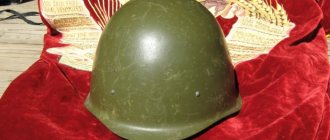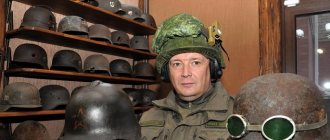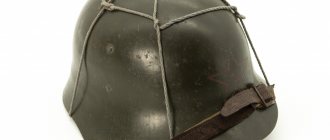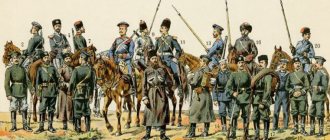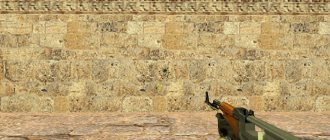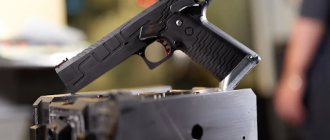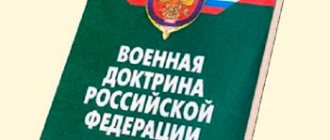Every man, especially those who served, will agree that military clothing is considered the key to the high combat effectiveness of military forces. In Russia, military uniforms always meet all the necessary requirements: they are reliable, comfortable and perform all their main functions. Today in Russia every soldier of the military forces is equipped with a military uniform. Still, uniforms are one of the important aspects of service.
Let's look at what military helmets are, when they began to be used, the first English, French and German military helmets.
How did the concept of “helmet” come about?
A special piece of clothing designed to protect a warrior’s head during battle was originally called a helmet. Since it was a continuation of the armor and was also made of iron, the military command included it in the standard combat kit under the official name “steel helmet” and recognized it as an effective means of individual protection for a fighter.
With the advent of various types of troops and the improvement of military craft, helmets began to be modernized. The products were dome-shaped. Steel was used to make them. But history knows examples made of felt and leather, the protective properties of which were ensured by a large number of metal elements attached to them. Due to the presence of these steel parts, the headdress was associated with iron. Over time, a more convenient word “casque” appeared in everyday life, which in Latin means “metal helmet.”
Construction of helmets
Wartime helmets have always been a subject for research by historians and archaeologists, who have thoroughly studied all the structural features and forms of soldier’s personal protective equipment, which have been widely used for thousands of years. Scientific research suggests that the main part of the protective helmet design has remained unchanged for many centuries. The changes affected only the form. It depended on the development of weapons and destructive weapons, from which it was obliged to protect.
Metal was used as a material for making helmets. These were thin sheets of bronze or copper, which were eventually replaced by steel or iron. It was helmets made of iron sheets that were used by all armies of the world until the 80s of the twentieth century. Later, military helmets and helmets began to be made from modern materials such as titanium, Kevlar, fabric polymers, and a compound of titanium and aluminum.
The internal structure of the helmet is represented by a special leather part, fastened with rivets around the circumference in the lower inner part of the product. This part of the helmet is called the “tuleyka”. It branches out using slits into several petals connected by a cord. The main functions performed by the crown and petals:
- ensuring a balanced fit of the helmet on the head;
- preventing head contact with the metal sheet of the helmet;
- softening the impact of fragments and stones on the outer part of the helmet.
Modern military helmets are more comfortable and safe for a soldier, since the petals contain additional foam or leather pads attached to them, enhancing the softness.
The appearance of combat helmets in France
Until the outbreak of the First World War, soldiers of European countries did without protective helmets. The army abandoned armor long ago, so a helmet protecting the head was considered an element of ancient armor that had no place in the modern army. However, the First World War, which was unofficially called the “trench war,” showed that abandoning soldiers’ helmets was a rash decision.
Since it was necessary to stick out of the trenches, the soldiers’ heads were the first to feel how bad they felt without reliable protection. Most soldier deaths occurred from hits to the head. Seeing the monstrous losses of personnel that occur in war every day, the generals of European countries became seriously worried.
The first special-purpose helmets were developed in France. Before their appearance, French soldiers wore cloth caps, which could only protect their heads from bad weather. The first French helmet was called “Adriana” and began to be mass-produced already in 1915. It was not one-piece and consisted of the following parts:
- Cap;
- Comb;
- Skirts.
Immediately after the appearance of helmets, the losses of the French army decreased significantly. For example, the total number of wounded decreased by 30%, and those killed by 12-13%. It is worth considering the important fact that the French helmet was not intended to protect against bullets. He, of course, could ricochet a bullet that hit him along a lateral trajectory, but he could not withstand a direct hit.
Seeing the unexpected success in “reanimating” such a seemingly outdated element of protection as a helmet, the allied countries hastened to purchase huge quantities of “Adrian” for their armies. The following countries have purchased such protection:
- Russia;
- Romania;
- Italy;
- Portugal;
- Great Britain.
All of the above countries, except England, were very pleased with the protective properties of French helmets.
English soldier helmets
The British military leadership, which purchased a large batch of French helmets, remained very dissatisfied with their protective qualities. A commission was created to develop their own helmet, which would be better than the French counterpart. It is possible that this decision was made because of the pride of the British military aristocracy, which considered it shameful to use helmets invented by the “frogmen” in war.
After reviewing several options, the British military command chose the design of John Brodie, who presented his own model of a helmet, very much reminiscent of the medieval English Capellin iron hat. English soldiers fought in such helmets in the 11th-16th centuries. After minor modifications, the helmet was adopted by the British army under the name "Helmet Steel Mk1".
Unlike the French model, the English helmet was one-piece and had wide edges along the entire perimeter. It was perfect for protection in a trench, as the wide fields protected against shrapnel and shrapnel from above. But every attack in it was very risky, because the helmet did not protect the back of the head, temples and ears at all. Since the British troops did not go on the attack too often, this helmet was not only liked by the British military, but was also adopted by several countries very friendly to Great Britain. These were:
- USA;
- Canada;
- Australia.
It is clear that these 3 countries, due to the fact that they practically did not participate in hostilities, had helmets only for “order.”
Modern models of Russian military helmets
Since there are currently much more SSh-68 helmets than is required by the Russian army, their production has been discontinued. Now the Russian military industry is mastering the production of new models of helmets, which are made of new and modern materials on a fabric-polymer basis. New models of helmets are much lighter and more comfortable than their steel counterparts, and most importantly, their protective properties exceed those of steel helmets.
The first helmet that was produced in Russia using modern materials is called 6B7. It entered service with the Russian army back in 2000. Russian special forces, airborne troops, marines and other similar units received similar protection.
In 2006, using the 6B7 helmet as a base, the Steel Research Institute produced a new helmet for Russian special forces - 6B27, which in its protective characteristics surpasses most foreign analogues.
Currently, designers at the Steel Research Institute are working on improvements to the unique Ratnik-BSh helmet, which has no analogues in the world.
Military helmets in Germany
When Germany's opponents had been using head protection for over a year, German soldiers continued to make do without it. Only in 1916 did the first German helmets appear, which were quite different from what the representatives of the Entente bloc wore. Most likely, the Germans were simply not satisfied with the design of the French and English helmets because they could not withstand a frontal bullet hit.
In early 1916, Germany developed its own helmet called the M-16 "Stahihelm", which was significantly different from the enemy's protection. Specific “horns” located on the sides made the appearance of the new military helmet easily recognizable. They not only covered the ventilation holes, but also served as an element for fastening the armored shield that covered the frontal part. Such armor made it almost impossible for a helmet to be penetrated by a rifle or machine-gun bullet.
However, as it turned out, it was better to avoid a direct hit to the forehead. The helmet perfectly withstood even a machine-gun bullet, but the soldiers’ necks turned out to be absolutely unprepared for such tests of strength. Cervical vertebrae were injured or even broken, which in some cases led to death.
Among the soldiers there was an interesting technique that made it possible to keep the neck intact in the event of a frontal bullet hit. To do this, the strap on the helmet was not fastened, and it simply flew off the soldier’s head. As a result of such a trick, many managed to survive after receiving a bullet in the head.
Further attempts to create a more durable helmet were also unsuccessful, because increasing the thickness of the armor gave the helmet extra weight, and the neck still broke.
Major improvement over predecessor
Was the USSR SSh-40 helmet the first means of protecting the head of privates? It turns out not. Before it, the SSh-39 was tested - a year earlier. However, it did not pass the tests, since it had a too complex, inconvenient and insufficiently reliable armrest.
As a result, certain changes were made to the design. In addition, to increase the strength of the connection between the cuff and the helmet, six rivets were now used, rather than three as before.
What kind of helmets were there in the USSR after the revolution?
If you look at chronicles or old photographs of the first years after the emergence of Soviet Russia, you can see that the main headdress of the Red Army soldier was the Budenovka hat. A small number of metal helmets were preserved in military warehouses, which the Soviet Republic “inherited” from the tsarist government, but most often they flashed at various military reviews and parades.
The first Soviet iron helmet was created in 1929. Outwardly, it resembled the famous M-17 “Sohlberg”, which was produced in Tsarist Russia. A pilot batch of experimental helmets, called M-29, was produced. Due to the fact that the production process was very labor-intensive and expensive, this model was never mass-produced.
The political situation in Europe in the 30s of the 20th century showed the USSR that soldiers needed a massive metal helmet. This is how the first mass-produced Soviet helmet, SSh-36, came into being. The soldiers in them went through many military conflicts:
- Polish campaign;
- Khalkhin Gol;
- Finnish War;
- Spanish Civil War;
- Battles on Lake Khasan.
This helmet was created on the basis of the German M-16 “Stahihelm” helmet, but was significantly inferior to it in terms of tactical and technical characteristics. The helmet turned out to be too heavy, its weight reached 1.3 kg. At the same time, the thickness of the helmet metal, equal to 1.1 mm, was insufficient to protect against bullets and large fragments. The shape of the helmet, which had a wide brim, interfered with visibility, and the wind could sometimes simply blow such a helmet off a fighter’s head.
It was soon replaced by a new model, which was named SSh-39 (SSh-40 since 1940). This helmet is a real legend, since it was in them that the soldiers of the USSR were able to defeat fascism. The new army helmet had the following advantages:
- It was made of alloy armor steel;
- The wall thickness was 1.9 mm;
- Moreover, the weight was even slightly less than that of the SSh-36 and amounted to 1.25 kg;
- The helmet withstood a frontal shot from a revolver at a distance of 10 meters.
In 1940, SSh-39 was modernized. The sub-hull system was replaced, after which the helmet was renamed SSh-40. It is under this name that she is known all over the world. Even now, these protection options have not been removed from service and are stored in large quantities in Russian military warehouses.
Subsequently, the SSh-40 helmet was modernized several times. These modifications took place in 1954 and 1960. In both cases, the modernization consisted of replacing the sub-tool device with a more advanced one, but in essence, all these modifications were a slightly modified model of the SSh-39.
New Russian helmet 6B47 “Ratnik”
Although the latest Russian Ratnik equipment is still being tested, one of its elements is already being mass-produced - the 6B47 Ratnik protective helmet. It differs from previous Russian developments in its weight, which is less than 1 kg, and small dimensions. At the same time, this helmet is much stronger than its heavier “brothers”. Such characteristics were achieved through the use of the latest composites for its production.
This helmet has a three-layer protection system. The outer and inner layers are made of hard composites, between which a layer of aramid material is placed. This helmet in its functionality is more reminiscent of a modern pilot's helmet. It is equipped with a communication system and a monitor onto which the image from the optical sight is projected.
